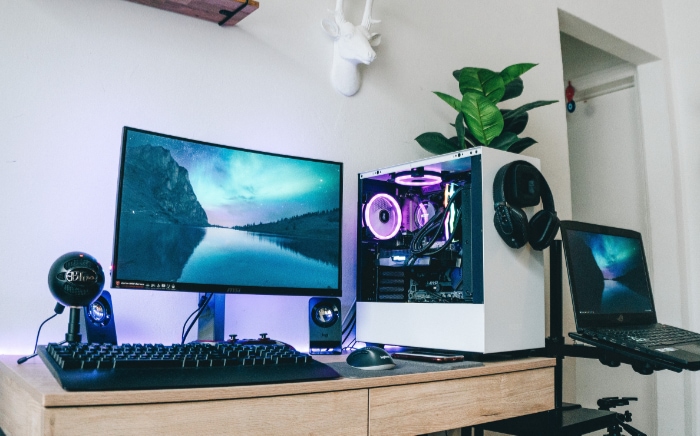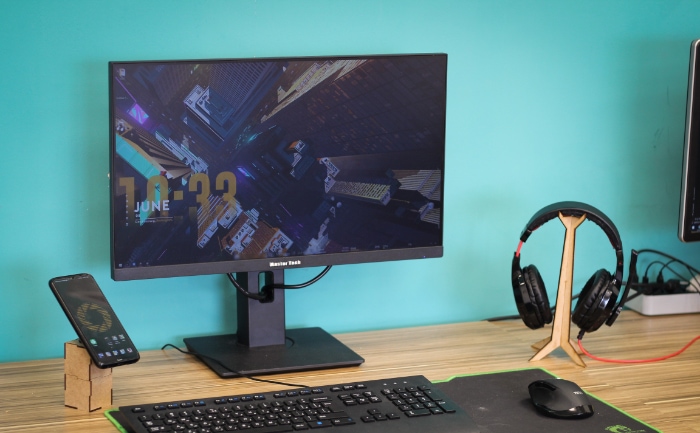Is 1440p Worth It for Gaming? The Resolution Dilemma

In the world of gaming, the experience delivered is determined by several factors: the gameplay itself, the story, the sound design, and of course, the visual fidelity. Resolution plays a pivotal role in defining this visual aspect.
It determines the sharpness and detail of the images and graphics you see on your screen. But with a wide array of resolutions to choose from, from the standard 1080p to the ultra-high-definition 4K, it can be a challenge to discern which one delivers the best gaming experience.
Enter 1440p, also known as QHD (Quad High Definition), a resolution that sits comfortably in the middle of the 1080p and 4K spectrum. For many, it offers a desirable balance between visual quality and performance demands.
But is it worth it? Does the improvement in image detail justify the increased hardware requirements and cost?
Understanding the 1440p Resolution
1440p, also known as QHD or Quad High Definition, is a display resolution that has a width of 2560 pixels and a height of 1440 pixels. This results in a total pixel count of 3,686,400, making it four times more detailed than the 720p HD resolution, hence the name Quad High Definition.
The “p” in 1440p stands for “progressive scan,” meaning the image is not interlaced and each pixel is refreshed in every single frame.
Comparison to Other Resolutions
In comparison, the more commonly used 1080p (Full HD) resolution has 1920 pixels in width and 1080 pixels in height, totaling 2,073,600 pixels. On the other hand, the 4K resolution, also known as UHD or Ultra High Definition, has 3840 pixels in width and 2160 pixels in height, leading to a staggering 8,294,400 pixels.
So, 1440p lies between 1080p and 4K, offering a significantly higher pixel count than 1080p, but not as demanding as 4K.
Games Supporting 1440p Resolution
While not every game supports 1440p natively, the majority of contemporary AAA games do. For instance, titles like “The Witcher 3: Wild Hunt”, “Red Dead Redemption 2”, and the “Assassin’s Creed” series, among many others, support this resolution.
Furthermore, game developers are increasingly acknowledging the growing popularity of 1440p and thus, newer games are more likely to support it. This trend is not only limited to PC gaming but is also being seen in the latest generation consoles like PlayStation 5 and Xbox Series X.
The Impact of 1440p on Gaming
The step up from 1080p to 1440p can have a noticeable impact on the visual quality of your games. The higher pixel count translates to finer detail, sharper images, and an overall more immersive gaming experience.
In particular, games with high-quality textures and detailed environments can truly shine at this resolution.
The increase in pixel density also offers more screen real estate, which can enhance your field of view in games, making them more immersive. This is particularly beneficial in strategy games where a larger field of view allows you to see more of the game map, or in first-person shooters where it can give you a competitive edge.
The Advantages and Disadvantages of Gaming at 1440p
Improved Visuals and Detail
As mentioned earlier, the biggest advantage of gaming at 1440p is the improved image quality. With more pixels to work with, everything from character models to environmental details can be rendered with more precision, making your games look better than ever.
Potential Drawbacks
However, these advantages do come at a cost. The first and foremost drawback of 1440p gaming is the increased hardware demand. To run games smoothly at this resolution, you’ll need a more powerful graphics card and a capable processor.
Another potential drawback is the cost. Not only do you need a higher-end PC to handle 1440p gaming, but you’ll also need a 1440p monitor, which can be more expensive than their 1080p counterparts.
Moreover, running games at a higher resolution can consume more power and generate more heat, which might require a better cooling system for your PC.
Lastly, not all games are optimized for 1440p. While most modern games support this resolution, some older or less graphically-intensive games might not look as good when scaled up to 1440p.
Balancing Performance and Visual Fidelity
When considering the move to 1440p, it’s important to consider your priorities. If maximum visual fidelity is your goal, and you have the hardware and budget to support it, 1440p offers a significant upgrade over 1080p.
However, if performance and cost-effectiveness are more important to you, staying with 1080p may be the more sensible choice.
Hardware Requirements for 1440p Gaming

Achieving a stable and smooth gaming experience at 1440p requires more than just changing your game settings. Your PC needs the right hardware, primarily a powerful graphics card, to handle the increased pixel count.
But other components, such as the processor, RAM, and of course, a 1440p monitor, also play essential roles. Let’s take a detailed look at each component.
Key Components for 1440p Gaming
Graphics Card
The graphics card, or GPU, is the most crucial component for 1440p gaming. You’ll need a high-end card that can handle the increased workload of rendering more pixels.
The specific model will depend on the games you play and the level of graphical detail you aim for, but generally, you should look at high-performance options from manufacturers like NVIDIA and AMD.
Processor
While the GPU does most of the heavy lifting in gaming, having a capable processor, or CPU, is also important. A good CPU ensures that your GPU gets the data it needs to render images efficiently.
For 1440p gaming, a recent multi-core processor from AMD or Intel should suffice for most games.
RAM
Sufficient RAM is essential for smooth gaming, especially at higher resolutions. While the exact amount of RAM you’ll need can vary depending on the specific games you play, 16GB is generally considered a good starting point for 1440p gaming.
Monitor
Finally, you’ll need a monitor that can display 1440p resolution. These monitors come in various sizes, but larger screens (27 inches and up) are often recommended to fully appreciate the increased detail that 1440p provides.
Cost Comparison: 1440p versus 1080p and 4K Systems
Moving to 1440p gaming will likely require a more significant investment compared to a 1080p setup, given the need for a more powerful GPU, possibly a better CPU, and a 1440p monitor.
However, it’s worth noting that a 1440p gaming system is generally less expensive than a 4K one, since 4K gaming requires the most top-tier components to run smoothly.
1440p and the Future of Gaming
With technological advancements being at the forefront of the gaming industry, resolutions continue to climb higher. 4K, for instance, is becoming increasingly popular, especially with the advent of next-generation consoles like the PlayStation 5 and Xbox Series X, which support this resolution.
However, the middle ground of 1440p is seeing a rise in popularity too. As we’ve mentioned before, 1440p provides a noticeable improvement over 1080p while being less demanding than 4K.
It’s being adopted more frequently not only by PC gamers but also by console gamers, as the new generation consoles also support this resolution.
Predicting the Role of 1440p in the Future
Looking into the future, 1440p seems to be on track to become a standard resolution for gamers who seek a balance between visual fidelity and performance.
While 4K gaming might become more accessible with advancements in technology and falling hardware prices, it’s likely that 1440p will continue to be a popular choice, especially among gamers on a budget or those who prioritize higher frame rates over the ultimate resolution.
There’s also a growing trend towards higher refresh rates in gaming, where many gamers prefer smoother gameplay over higher resolutions. Given that achieving higher refresh rates is easier with 1440p than with 4K, this could further solidify the place of 1440p in the gaming world.
Future-proofing Your Gaming Setup
When deciding whether or not to invest in a 1440p setup, consider not just your current needs but also future-proofing your gaming rig. If you plan on playing the latest AAA games for years to come or want to dive into Virtual Reality, a 1440p or even a 4K setup might be a worthy investment.
It’s clear that 1440p has carved out a niche in the gaming world, offering an appealing middle ground between performance and visuals. But, as we’ve seen, whether it’s worth it for you depends on various factors, from the games you play to the hardware you have or plan to buy.
Conclusion: Is 1440p Worth It for Gaming?
Throughout this exploration, we’ve discovered several key points about 1440p gaming. It’s clear that the upgrade to 1440p can offer a significant improvement in visual quality, enhancing the overall gaming experience.
We’ve also seen that the hardware required for 1440p is more demanding (and potentially more costly) than that for 1080p, but less so than for 4K gaming.
Moreover, while 1440p offers a middle ground between 1080p and 4K, whether it’s the ‘sweet spot’ depends on the individual gamer. The balance of quality and performance that 1440p offers makes it an appealing choice, particularly for those aiming for higher frame rates or gaming on a budget.
Personal Recommendations and Insights
Is 1440p worth it for gaming? The answer to this question isn’t a simple yes or no. Instead, it heavily depends on your personal gaming preferences, the hardware you have or are willing to invest in, and the types of games you play.
If you’re a gamer seeking a noticeable upgrade from 1080p in terms of image quality, and have the necessary hardware, or are willing to invest in it, then 1440p could be a worthwhile step up.
It’s especially worth considering if you’re into AAA titles that have high-quality graphics and textures, where the enhanced detail of 1440p can truly shine.
However, if you’re a casual gamer or primarily play less graphically-demanding games, sticking with 1080p might make more sense. Likewise, if achieving the highest possible frame rates is your priority, you might find better value in investing in a higher refresh rate monitor at 1080p.
The Final Verdict
In conclusion, 1440p gaming can be worth it if you value a better visual experience and have the necessary hardware and budget. As always, it’s about finding the right balance that suits your gaming preferences and needs.
So whether you stick with 1080p, move to 1440p, or even aim for 4K, the best resolution for you is the one that delivers the most satisfying gaming experience.


